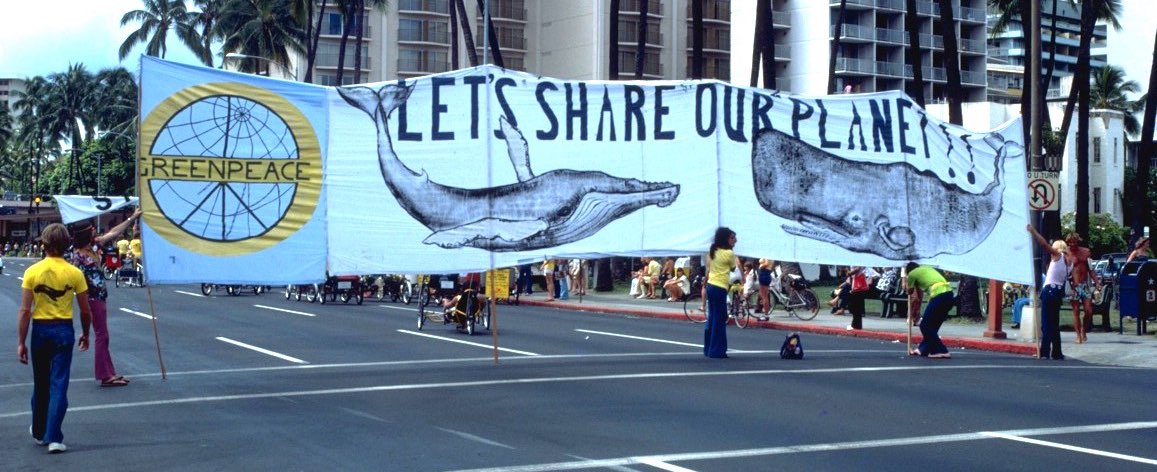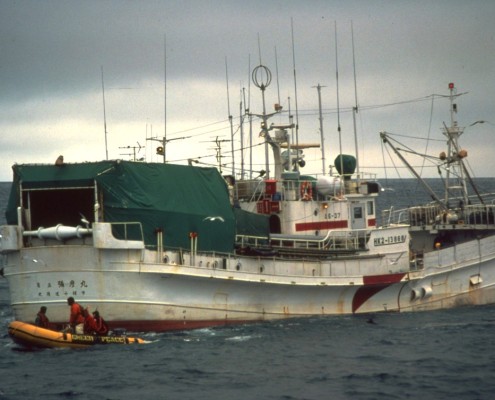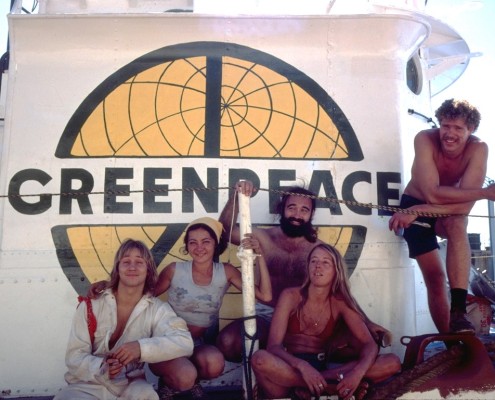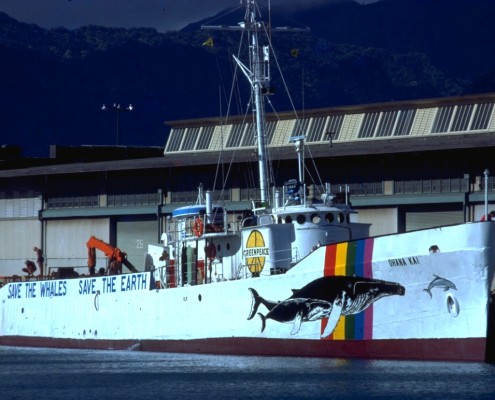Greenpeace Foundation
Organizational Information
Organizational Information
Greenpeace Foundation is a USA 501 (c) 3 nonprofit corporation, incorporated in 1976 and maintaining tax-deductible status in good standing since its inception.
It’s federal tax number is 99-0175939, and US donations to it are fully deductible.
Greenpeace Foundation’s administrative headquarters are located at
GREENPEACE FOUNDATION
1118 Maunawili Road
Kailua, HI 96734 USA
phone: (415) 689-9931
fax: (206) 202-3893
email: email@gpfdn.com
Greenpeace Foundation is a 501(c)3 publicly-supported nonprofit organization, and not a “foundation” in the sense of being chartered as legal foundation.
Greenpeace Foundation Historic Firsts
![]()
Greenpeace Foundation has been a pioneer on many issues. It was either the first, or one of the first, organizations to work on a host of important issues. These include commercial whaling, Pirate whaling, Asian dolphin drive kills, destruction from driftnet fisheries, ending the dalls porpoise “research” kill, obtaining critical habitat for endangered monk seals, and many others.
How We Spend Your Donation
We consider donations to Greenpeace Foundation to be a sacred trust on behalf of life on earth, and treat them that way.
Our percentage breakdowns for overhead costs versus program may seem to good to be true, and there’s a reason for that. As co-founders of the global GP movement, we saw that how a primary focus on fundraising could distort campaign priorities and internal structure, and make the organization seem an end in itself.
For that reason, Greenpeace Foundation pays no salaries and (aside from zero-overhead “donate” buttons on this site) and employs no aggressive fundraising tactics. It never acquires the bank account or charge card information of contributors, leaving all donation decisions in their hands. There isn’t a “fundraising” budget.
If a donation is designated for a specific campaign, that restriction is permanently honored. (For instance, if you give a designated donation for whale-saving, it will not be used for anything else).
We don’t do “make work” to “seem busy”. Funds are spent when and where they will do the most good. If that means waiting years for sufficient designated funds and the right opportunities, we wait.
The organization maintains extremely low overhead, paying nothing for office space due to operating in a decentralized way. We’ve done the “big centralized office” thing, and found that while it looked impressive, it was inefficient.
While Greenpeace Foundation is very experienced at running deep-sea expeditions when necessary, it no longer maintains ships as a branding tool. Big ships are money pits, it’s the donors’ money, and the odds are that at any given time they aren’t sitting anywhere close to where you need them. Been there, done that, and it’s very fuel-intensive. If we need a ship these days, we’ll charter one close to where its needed and paint our name on it, paint being cheap.
That’s the percentage of donations we spend directly on environmental programs.
And that’s including the 3-5% charged by banks to process credit-card donations, an expense usually hidden from view on a charity website. If you do the math, our overhead costs are amazingly low.
Why? No salaries, no commissioned employees. Extremely low admin overhead. Essentially no funds spent on fundraising. Isn’t this the way it should be done?
History of the GP Movement
As the “Greenpeace” movement spread around the planet in the ’70’s through the mid-80’s, many organizations were founded and a huge amount of inspiring work was done by a high diversity of networked grassroots activists. This is when the movement became well-known for guts, smart campaigns, derring-do, and telling it like it is.
By the mid-80’s, this global movement was being pulled in various directions. Some felt that it should maintain its low-overhead, high-innovation, decentralized structure dedicated to protecting the integrity of global ecosystems and species with inspired volunteer participation. Others felt that would be better to centralize, raise a lot of money, hire a lot of permanent staff, specialize in hanging big signs on things, and focus more on human issues than on the ecosystem and other species.
Both paths were taken. Greenpeace Foundation (this group) is the surviving organization which held to the first path, while Greenpeace International and its affiliates followed the “centralization” path. The directors of Greenpeace Foundation co-founded both of them, and wish GPINTL well, but believe that the original vision of the GP movement and its ethics represent a higher standard and a far more effective use of funds. For a longer discussion on how this all came down, click here.
Last time we checked, you won’t find this mentioned on their websites. Know who you’re supporting, and give some thought to how the organization you donate to will use your support.
What We Do
Greenpeace Foundation exists to intervene intelligently for the future of earth’s living species.
It’s campaigns are nonviolent, action-oriented, and focused on improving the prospects for large complex life – including humans – to prosper on a healthy planet.
It’s not our role to pass around petitions. We exist to think of, and carry out, strategies to change the course of history. Things that make humans around the world think differently about their world and the future.
It does this at a crucial time. The human race has grown exponentially in impact on the world, and the future of the earth, its species, and the human race depend deeply on what does and doesn’t happen century.
We are already well into the “Anthropocene” era, in which the actions of humans are the principle determiner of which species survive. And that’s not going so well.
It’s clear that we are on the cusp of the 6th great planetary extinction of the last billion years. Such events permanently change the very nature of life, and cause existing large complex species to be quickly snuffed out, and then and slowly replaced over millions of years. Large species like whales, dolphins, elephants, seals… and humans.
Since 1976 we have been on the front lines of the fight against the 6th extinction. We believe that humans need to “bear witness” to the reality of what’s being lost, what’s being done on our behalf, because that forces those who see it, to actually make decisions.
We believe that evolved species and ecosystems are NOT expendable. Yes, life will evolve to fill trophic gaps, but it will not be the same life. Whales, dolphins, seal and large fish may be replaced by jellyfish and bacterial slimes. Large land animals would likely be replaced by much smaller animals which can more quickly adapt. The large animals we know will not come again, if we allow them to disappear.
We’re about intelligent advocacy for these species, on behalf of a future in which a green and peaceful planet can support human childhoods for millions of years. That is not the future currently in store, but it’s a future worth fighting for.
How We Do It
Greenpeace Foundation campaigns work to expose what’s really going on with the world’s environment, and help good people to engage with that reality.
We re-frame the crucial issues of planetary health in more realistic and productive ways, using what the Greenpeace movement’s co-founder Bob Hunter called “mind bombs”: the use of dramatic situations and imagery which can immediately clarify a complex issue.
We work to inspire people of all ages, from all walks of life, to get involved on behalf of their planet’s future. Because some things are worth taking a stand for, and the future of our planet and its species must top that list.
We maintain and encourage a high standard of science-based fact-finding and decision-making, because science is the way to deal with physical-world problems.
We work to shift the culture away from it’s short-term focus on quick reward, and toward a long-term focus on ecological realities.
We leverage the available facts and images to do the most good for threatened species and ecosystems.
We think and act outside the usual behavioral boxes, using a different toolkit of tactics than other other groups, because at this point that’s where progress can be made.
We use strategic timing in the expenditure of campaign assets. Making a positive difference is the only criterion that matters.
We do this because we believe it’s the right thing to do. Nobody at Greenpeace Foundation takes a permanent salary or earns a commission. We don’t chase people for donations or do mass mailings.
Why We Do It
The reason it’s called “Greenpeace Foundation” is that it is meant to provide a foundation of ideas for a new way of conducting human affairs as we face many converging crises. (It is meant in the sense of Isaac Asimov’s classic “Foundation Trilogy” with a similar theme of getting humanity through a huge crisis in the best possible way).
We’ve entered the 6th planetary mass extinction of Earth. It is not only the crisis of our time and our species, but the crisis of our era. The world is burning, literally and figuratively, and the incredible web of life we have evolved within is failing from the weight of our actions.
This is a crucial time. Pretty much every ecological asset we depend upon is failing or about to. The oceans are overfished and acidifying, reefs bleaching and dissolving. There is maybe a quarter as much large animal weight on earth as there was 60 years ago. Species are dying at thousands of times the normal background rate. The rainforests are burning. We’re on track, in the next few decades, to lock in a world climate no human has ever survived in.
It’s pretty much impossible these days not to know this. Some will think it’s fine to just let things happen. Some will decide that it is not. We think that’s it’s the most important decision humans will ever have to make, and that it needs to be made individually as well as collectively. Will we sleepwalk into ecocide, going out in a blaze of excess and taking other large species with us? Or are we willing to walk a more difficult path to a stable population on a planet with a healthy ecology?
This organization is a tool for you to use if you decide to make common cause with the species and humans which could exist for millions of years into the future.
Because as things stand, that’s not what’s going to happen. Join us.
GREENPEACE FOUNDATION MISSION STATEMENT
Greenpeace Foundation is a no-nonsense advocate for species conservation and biodiversity on a healthy planet. It is grounded both in science and in a reverence for life. It exists to help dedicated people make a difference in the world through smart, gutsy work; good science; and “bearing witness” to environmental problems to bring them into public scrutiny. Its primary focus is the marine ecosystem; and interaction of human activity with that ecosystem. It has taken up marine mammal and fisheries issues as important indicators of health of the seas. Greenpeace Foundation’s work is based on innovation, action, efficiency and accountability in the service of life.
Greenpeace Foundation is dedicated to solving and preventing environmental crises, preserving the ecosystem for future generations of people and animals to enjoy. As humans can speak for themselves, it is an unabashed advocate for species which cannot, upholding the founding ideals of the Greenpeace movement.
GREENPEACE FOUNDATION
1118 Maunawili Road
Kailua, HI 96734 USA
The USA’s oldest and original Greenpeace, proudly unaffiliated with Greenpeace USA







